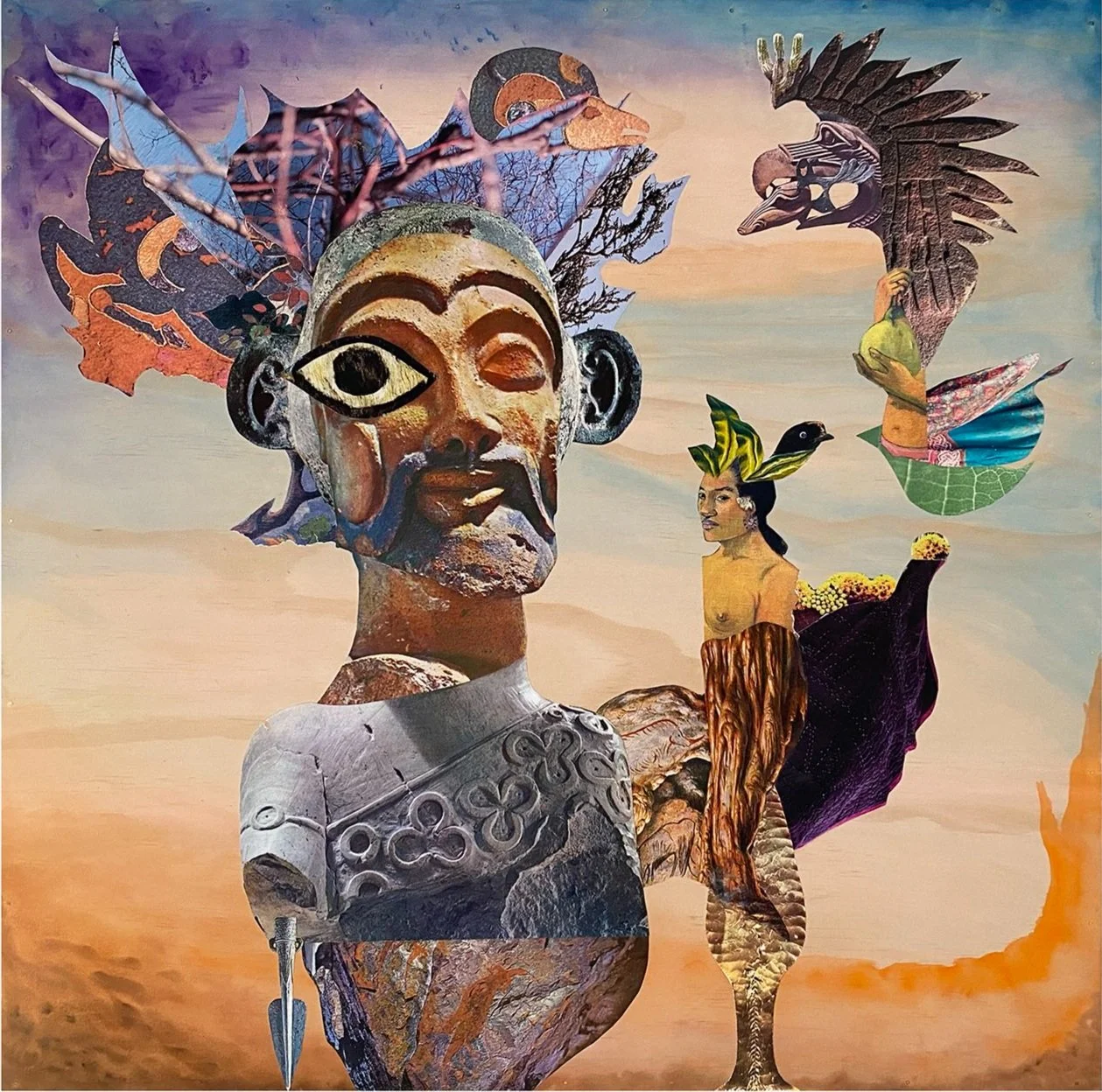The Patriarchy and Women Artists
The Offering, by Christy Higgins, 2021, Mixed-media collage on wood box panel, 26” x 26”. Original artwork and prints available.
For the past few months, I’ve been spellbound by Katy Hessel’s recently published book The Story of Art Without Men. Taking my time to reimagine the history of art with so many new-to-me characters has been a revelation, not to mention an inspiration and an empowering new awareness in which to dwell. They have largely been ignored by history books, but women have been creating important, culturally relevant work alongside men with every step of our evolution. We all know intuitively that women are creators and artists, but historically, their art and creative expression have largely been restricted to a domestic framework (also vitally important to human life) and relegated to the ranks of “low art”. What studied men did was considered “high art” (intellectual and spiritual, serving a “higher” purpose than domestic life), and women were excluded from entry into that world for centuries.
While many of my favorite artists are women, I’m ashamed to admit that I was unaware of how many women artists I’d never even heard of, and how much women have been left out of the history of art. Not only have we collectively looked past the women who were brave enough to buck the system and become artists, but we’ve also been severely deprived of what was never created nor added to the “story of us” through the absence of the voices and perspectives of women who could not find their way through the labyrinth of obstacles created by society. Up until the end of the 19th century, women weren’t given access to the things they needed to become part of the public story; instead, they were largely made to lie dormant within their roles as child-bearers, wives, housekeepers, and muses. For thousands of years in human history, women have been blocked from public life and shut indoors, requiring chaperones to leave the house or enter churches or schools, where artists historically learned their craft.
While I have been aware of these inequities for most of my life, the more powerful experience for me in reading this book has been connecting with deep, pent-up feelings about being a woman raised in a patriarchal society. Hessel’s book reveals the extent to which women have been left out of an essential part of our cultural myth-making, where our individual stories are woven into a larger tapestry of our shared group experience, reflecting ourselves back to ourselves. Like a giant mirror, art’s more complete story—including women—has not only been reawakening my personal experiences with and feelings about life as a female in a patriarchal society, but it is also helping me to see the larger picture of domination, oppression, and discrimination against women that has been baked into our species’ social systems for thousands of years.
What happens to a group narrative and the myth-making process when we don’t acknowledge women’s inherent value beyond quotidian tasks? It creates a story of fragmented hierarchies rather than cohesion and cooperation, which are group qualities that are naturally derived from feminine forms of power. What happens to a culture that allows only certain members to be acknowledged and participate in the “story of us?” Those who are not allowed to participate become fragmented into disenfranchised factions that feel they need to battle others in order to secure their place in the hierarchy, thereby perpetuating the cycle of violence that is the hallmark of toxic masculinity. Patriarchy—a system of society in which men hold the power and women are largely excluded from it—is a poisonous system that ignores the natural balance that feminine and ecological value systems provide. And it’s not just women who suffer under this global tyrant of historical precedent; men suffer, as well. All of the individuals within a culture suffer when their collective story is a lie. And among the lies we have been telling ourselves is that men are more important than women.
Each person contains a combination of masculine and feminine forms of energy, which has nothing to do with gender, but rather an interaction of physical forces that create the material universe. Patriarchy, however, pits the sexes against each other rather than seeing the natural benefits of finding balance between these opposite forces both within ourselves and in our relationship with the outside world. A balance between the masculine and feminine forms of power allows life to thrive for the individual as well as the collective whole. In doing so, everyone in that system becomes a beneficiary of the beauty and good that comes from that balance and equality.
Contemplating the women artists who opened the field for the rest of us gives me a feeling of gratitude, a sense of pride, connection, and encouragement to keep creating, expressing, and revitalizing our cultural narratives through art. While I feel expanded and more connected on one hand, on the other, I’m becoming more aware of how numb I have become to the patriarchal paradigm into which we have all been indoctrinated. In this way, I am waking up to many contradictions that I have lived with on a daily basis. Albeit unconsciously, I now realize that I, too, have habitually ranked women as less important than their male counterparts. I am, however, waking up to my ignorance, my disowned feelings of despair, rage, betrayal, and grief, and am reconnecting with the younger me that had those discordant experiences, and the current me that still does.
The more I learn about how the women who came before me overcame great obstacles to become artists, the more I’m beginning to feel a sense of sisterhood and belonging to a greater collective of women artists through the ages. While I have had greater opportunities to explore my options than my predecessors, I have been a victim of patriarchy, too. As early as elementary school, when I was a classic “tomboy,” I learned through the behavior of my teachers and other authority figures that I wasn’t as valuable to society as males were. While I didn’t have a name for it yet, I remember that it hit me like a shock wave. This message was completely counter to my innate, internal experience, which was that each of us is monumentally important to the world, regardless of gender, just as we are.
Subliminal though they may be, these cultural narratives give us the foundation of our identity and either bond us together as a whole, or exclude us from opportunity and self-esteem. They create the context of our lives and tell us about who we are in relation to the whole, an essential aspect of being pack animals. As these stories are told, we take them deeply into our psyches as truth, and build our identities around them. They shape who we are as individuals and as a society. But now we have the opportunity to wake up to the catastrophe of the incomplete human story, and embolden ourselves to be the change we want to see in the world. Not only do both men and women need a new paradigm, but our planet does, as well.
NOTES & RESOURCES:
Hessel, Katy. The Story of Art Without Men. W. W. Norton and Company, 2023.

